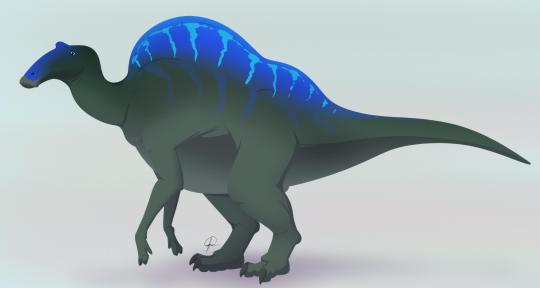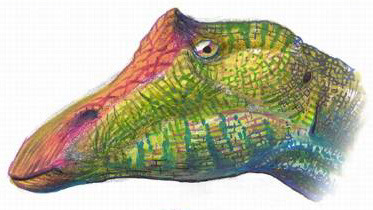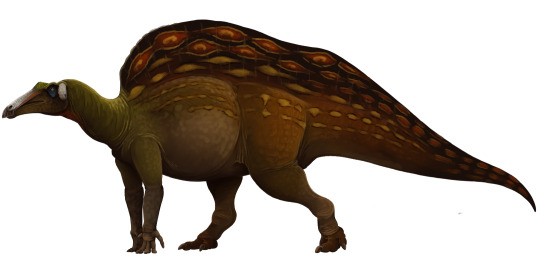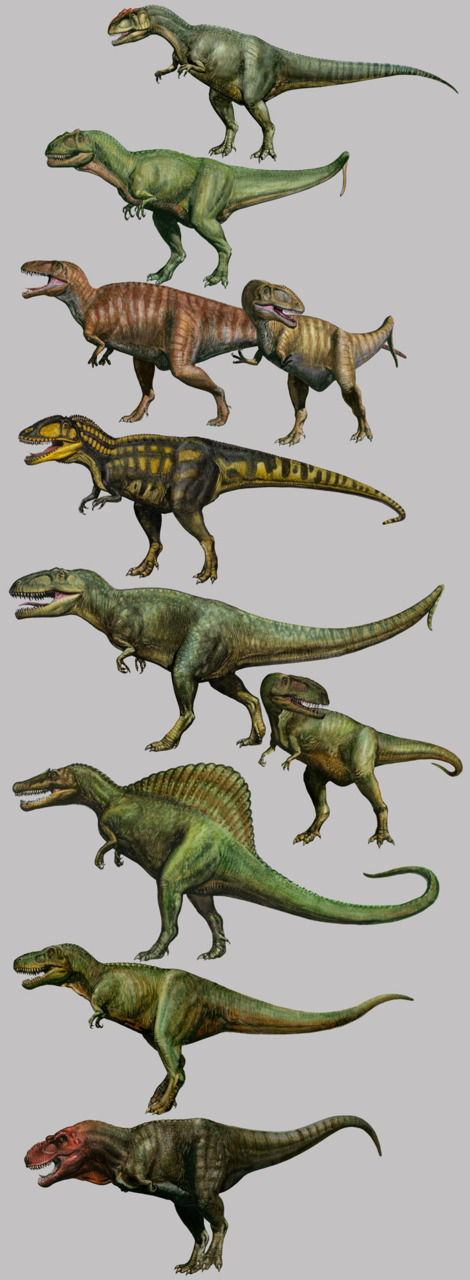#eocarcharia
Text

A dinosaur tooth of an Eocarcharia dinops from the Elrhaz Formation in Gadoufaoua, Niger. This species is often erroneously replaced or mistaken with the younger and much larger Carcharodontosaurus in media when featuring its contemporary genera such as Ouranosaurus or Sarcosuchus.
#fossils#dinosaur#paleontology#palaeontology#paleo#palaeo#eocarcharia#carcharodontosauridae#theropod#cretaceous#mesozoic#prehistoric#science#paleoblr#エオカルカリア#カルカロドントサウルス科#恐竜#化石#古生物学
32 notes
·
View notes
Text
"That was like a death match between two carnivorous dinosaurs" - Taromaru Rex


Fling Posse & Matenro here
#hypnosis mic#hypmic#buster bros#mad trigger crew#dinosaurs#theropods#achillobator#eocarcharia#suchomimus#aerosteon#monolophosaurus#spectrovenator#dinosona#cs art#ichiro yamada#jiro yamada#saburo yamada#samatoki aohitsugi#jyuto iruma#rio busujima
5 notes
·
View notes
Text
Dinofact #107
Considered one of the earliest known abelisaurids, Kryptops is notable for the heavily textured surface of its maxilla, indicating that there was likely a covering, likely of keratin, attached firmly to its face. A cladistic analysis conducted by Paul Serano and Stephen Brusatte found Kryptops to be the most basal Abelisaurid known. A later study, however, by Matthew Carrano and colleagues, found Kryptops palaios to be a chimera, stating that its postcranial remains actually belong to a Carcharodontosaurid, possibly Eocarcharia dinops.
Source: Wikipedia
#dinosaur#dinosaurs#paleontology#kryptops#kryptops palaios#abelisaurid#abelisaurids#abelisauridae#carcharodontosaurid#carcharodontosaurids#carcharodontosauridae#eocarcharia dinops#eocarcharia#paul serano#stephen brusatte#matthew carrano#fun facts#trivia#dinosaur trivia#dinosaur fun facts#20th#december#2022#december 20th#december 2022#december 20th 2022
5 notes
·
View notes
Text
Eocarcharia doodle

0 notes
Text








@mystic--romance--of--christ I’ve made some gifs for you of Dino Trackers and it’s even more funny without the dialogue or context.
#dino trackers#mini series#really sends me when the eocarcharia falls off and sends up a poof of dust
5 notes
·
View notes
Text
Siamraptor

Siamraptor was a genus of carcharodontosaurian dinosaur from the Early Cretaceous period. Its type species is S. suwati. The holotype was found in the Khok Kruat Formation in northeastern Thailand. Siamraptor is the first and currently only definite carcharodontosaurian known from Southeast Asia.
"Siam" is derived from the original name of Thailand, "raptor" is Latin for robber, and the specific name suwati refers to Suwat Liptapanlop, a supporter of the Northeastern Research Institute of Petrified Wood and Mineral Resources.
Its autapomorphies include a jugal with a straight ventral margin and a deep anterior process below the orbit, a surangular with a concavity and four posterior foramina, a groove along the suture between the surangular and prearticular, an articular with a formen at the suture with the prearticular, a cervical vertebra with an additional foramen that is excavating the parapophysis, and the presence of a pair of foramina at the base of the neural spine on the cervical and posterior dorsal vertebrae. Another possible autapomorphy specific to the genus may be a deep concavity excavating the posterior end of the lateral shelf.
Siamraptor is known from its holotype, consisting of a posterior right mandible including the surangular, prearticular, and articular; as well as referred material from three other individuals including three right premaxillae, a right and left maxillae, a left jugal, two posterior parts of the left mandible, three cervical vertebrae, a caudal vertebra, a manual ungual, a right ischium, a section of the left tibia, and a left pedal phalanx. Siamraptor was recovered as a definite carcharodontosaurian, though its relationships within the clade are uncertain. It may have been a derived member of Allosauria outside of Allosauridae or a basal member of Carcharosauria in a polytomy with Eocarcharia, Concavenator, and Neovenator.
Original paper: Original description paper
Wikipedia article: here
#dinosaur#dinosauria#paleoart#paleontology#artowkr#original art#human artist#siamraptor#carcharodontosauria#allosauria#carnosauria#tetanurae#theropoda#saurischia#obscure fossil animals#obscure fossil dinosaurs#obscure fossil tetrapods
12 notes
·
View notes
Text

#Archovember Day 24 - Araripesuchus wegeneri
The notosuchians were were such a diverse group of pseudosuchians you’d think they came from the Triassic. But no, this group of “mammal-mimicking” crocodylomorphs lived during the Jurassic and Cretaceous. One such Cretaceous notosuchian was Araripesuchus. This genus was widespread across the Southern Hemisphere, represented by at least 6 different species, mostly identified by their unique teeth. Today’s species is Araripesuchus wegeneri, the “Dog Croc.”

Living in Early Cretaceous Niger, Araripesuchus wegeneri appeared to be an omnivore, eating both plants and insects like grubs. Its common name “Dog Croc” is a reference to not only the dog-like shape of its skull, but also its unique caniniform teeth. Araripesuchus wegeneri fossils were found in a block with five skeletons packed together, so they may have even been social. All species of Araripesuchus had large eyes and thin osteoderms covering their body. They were likely more agile on land than in water, due to their long limbs. It could have possibly used its long legs to sprint to the water in order to flee predators, then used its muscular tail to swim.
There was a significant amount of pseudosuchian diversity in the Elrhaz Formation. Araripesuchus wegeneri would have lived alongside the similarly sized, duck-billed notosuchian Anatosuchus. It would have had to look out for the giant “Super Croc”, Sarcosuchus (perhaps the reason it had adapted for leaving the water so easily!) It would have also lived alongside the long-snouted fish-eater Stolokrosuchus. There were dinosaurs here as well, such as the iguanodont Lurdusaurus, the hadrosaur Ouranosaurus, the carcharodontosaurid Eocarcharia, the abelisaurid Kryptops, the spinosaurid Suchomimus, and the duck-billed sauropod Nigersaurus.
#my art#SaritaDrawsPalaeo#Araripesuchus wegeneri#Araripesuchus#notosuchians#pseudosuchians#archosaurs#archosauromorphs#reptiles#Archovember#archovember2023
10 notes
·
View notes
Text

Skeletal reconstruction of Eocarcharia dinops, a rather large sized carcharodontosaurid from the Elrhaz Formation.
12 notes
·
View notes
Text
Ouranosaurus nigeriensis

By José Carlos Cortés
Etymology: Brave Reptile of the Sky
First Described By: Taquet, 1976
Classification: Dinosauromorpha, Dinosauriformes, Dracohors, Dinosauria, Ornithischia, Genasauria, Neornithischia, Cerapoda, Ornithopoda, Iguanodontia, Dryomorpha, Ankylopollexia, Styracosterna, Hadrosauriformes
Status: Extinct
Time and Place: Sometime around 112 million years ago, in the Albian age of the Early Cretaceous


Ouranosaurus is known from the Elrhaz Formation of Agadez, Niger

Physical Description: Ouranosaurus is an exceptionally iconic dinosaur, primarily because of its very weird distinguishing physical feature: it has a sail. Probably. The reason for this idea is that Ouranosaurus had extremely high spines on its back, creating a notable ridge along the center of the animal. These spines become thicker and flatten as they go along the body, and bony (ossified) tendons ran across the spines and the tail. The spines grew biggest over the forelimbs, rather than over the hips. This structure may have been a sail; it also could have been a hump containing muscle or fat - similar to living bison and camels. This would have allowed for the storage of energy during the dry season or another time of year. If a sail, this structure would have been primarily one of display, flashing colors and patterns to communicate with other members of the species. It had very long forelimbs with lightly built hands, which had sharp thumb claws and the middle fingers built into a broad hoof-like structure. In short, it was capable of quadrupedal walking. It had very robust hindlimbs as well, and thus was able to walk bipedally in addition to quadrupedally. Ouranosaurus was quite large, reaching 7 meters in length and weighing somewhere around 2.2 tonnes - despite its length, it was fairly lightly built. With its sail, it was just under 3 meters tall. Being of such large size, it is unlikely that Ouranosaurus retained any fluffy covering; if it did, it was sparse and mainly ornamental.

By Slate Weasel, in the Public Domain
It had a very long, flat head, with an even longer snout that greatly surpassed the size of Ouranosaurus’ close relative, Iguanodon. It had a straight beak, rather than a curved one, and no teeth in the front of its snout. The snout also was covered in a sheath of horn, which made it wider and more like something of a beak. This beak was then followed by densely packed batteries of teeth in the cheeks, forming a single surface like those found in the much later Hadrosaurs. The jaws had fairly weak muscles, but this was made up for with a narrow back of the skull, which made the bite ability of the jaws greater to make up for the weak musculature. In short, Ouranosaurus, despite having a very different head than the later Hadrosaurs, was still a strong chewer. Interestingly enough, the eyebrows of Ouranosaurus featured small rounded horns - making Ouranosaurus the only known Ornithopod (Hadrosaurs and their close relatives) with horns. It had highly placed nostrils, and two small bumps between the nose and the eye socket for display.

By Pavel Riha CC BY-SA 3.0
Diet: Ouranosaurus primarily fed on leaves, fruit, and seeds, using its chewing to break up tougher plant material and to gain food from it. Given its decent height, Ouranosaurus would have been a mid-level browser.

By Audrey M. Horn, CC BY-SA 4.0
Behavior: Ouranosaurus would have spent most of its time foraging on a variety of plants in its ecosystem, wandering about the river delta searching for leaves, fruits, and other delicious foods. It is fairly unlikely that Ouranosaurus would have been a herding animal, as herds seemed to have been more of a behavior for Ornithopods more closely related to Hadrosaurs; instead, Ouranosaurus probably wandered about its environment alone, or in small family groups. That said, it almost certainly took care of its young in some capacity, and it did have complex social behaviors if the sail was a sail and used for display - and it used those bumps and horns on its head for display as well. It was also probably at least somewhat vocal. As for the spiked thumbs, those could have been used for defense, as well as in-fighting amongst members of the group. It wouldn’t have been a good runner, but it would have moved on two legs when needing to move at least somewhat faster, and stuck to four legs for most movements throughout the day. It probably would have used that narrow head to selectively grab a variety of foods from in between more dense foliage.

By Scott Reid
Ecosystem: Ouranosaurus lived in an extensive river delta, filled with extensive waterways and wetlands. These wide rivers were home to many animals, including a truly extensive number of dinosaurs. Plenty of trees, including ginkgoes and pines, and some flowering plants, in addition to horsetails and ferns, were present for Ouranosaurus to feed on. There were many types of fish and invertebrates, and the turtle Taquetochelys, but the archosaurs were the main stars of the show. There was the duck-croc Anatosuchus, the giant croc Sarcosuchus, and the running croc Araripesuchus on the Crocodylomorph side of things. There was a weirdo sauropod here too, the duck-billed Nigersaurus, which decidedly does not get enough press. As for other ornithopods, there was the fast-running biped Elrhazosaurus, and a close cousin of Ouranosaurus - Lurdusaurus, an equally-weird creature, with a long neck like a sauropod and the ability to live semi-aquatically in the river system. As for theropods, there was the possible Ornithomimosaur Afromimus, the mid-sized carnosaur Eocarcharia, the Abelisaurid Kryptops, and the spinosaur Suchomimus. You will note that Ouranosaurus did not live with Spinosaurus. This is a misconception. The two did not live together - never, not once, not even close, they are not found in the same place. Spinosaurus (probably) comes from later, and while it seems that it did live that southward, it decidedly did not live in the Elrhaz formation, because its job was being done by Suchomimus. As for predators, Ouranosaurus probably had to mostly watch out for Eocarcharia and Kryptops, as they would have been the main land predators of the area.

By Ripley Cook
Other: Ouranosaurus, being a Hadrosauriform, was most closely related to one of the more famous Ornithopods, Iguanodon, and shared the thumb spike in common with it. Interestingly enough, Ouranosaurus wasn’t the only hump or sail backed dinosaur at that point of the family tree; Morelladon, which lived much earlier, also supported some sort of odd structure on its back.
~ By Meig Dickson
Sources under the Cut
Bailey, J.B. (1997). "Neural spine elongation in dinosaurs: sailbacks or buffalo-backs?". Journal of Paleontology. 71 (6): 1124–1146.
Benton, Michael J. (2012). Prehistoric Life. Edinburgh, Scotland: Dorling Kindersley. p. 338.
Galton, P. M., and P. Taquet. 1982. Valdosaurus, a hypsilophodontid dinosaur from the Lower Cretaceous of Europe and Africa. Géobios 15(2):147-159
Larsson, H. C. E., and B. Gado. 2000. A new Early Cretaceous crocodyliform from Niger. Neues Jahrbuch für Geologie und Paläontologie - Abhandlungen 217(1):131-141
McDonald, A.T.; Kirkland, J.I.; DeBlieux, D.D.; Madsen, S.K.; Cavin, J.; Milner, A.R.C.; Panzarin, L. (2010). Farke, Andrew Allen (ed.). "New Basal Iguanodontians from the Cedar Mountain Formation of Utah and the Evolution of Thumb-Spiked Dinosaurs". PLoS ONE. 5 (11): e14075.
McDonald, A. T., (2011). "The taxonomy of species assigned to Camptosaurus (Dinosauria: Ornithopoda)" (PDF). Zootaxa. 2783: 52–68.
Palmer, D., ed. (1999). The Marshall Illustrated Encyclopedia of Dinosaurs and Prehistoric Animals. London: Marshall Editions. p. 144.
Paul, G.S. (2010). The Princeton Field Guide to Dinosaurs, Princeton University Press. p. 292.
Sereno, P. C., A. L. Beck, D. B. Dutheil, B. Gado, H. C. E. Larsson, G. H. Lyon, J. D. Marcot, O. W. M. Rauhut, R. W. Sadleir, C. A. Sidor, D. D. Varricchio, G. P. Wilson, and J. A. Wilson. 1998. A long-snouted predatory dinosaur from Africa and the evolution of spinosaurids. Science 282:1298-1302
Sereno, P. C.; H. C. Larsson; C. A. Sidor, and B. Gado. 2001. The giant crocodyliform Sarcosuchus from the Cretaceous of Africa. Science 294. 1516–1519.
Sereno, P. C.; Wilson, J. A.; Witmer, L. M.; Whitlock, J. A.; Maga, A.; Ide, O.; Rowe, T. A. (2007). "Structural extremes in a Cretaceous dinosaur". PLoS ONE. 2 (11): e1230.
Sereno, Paul C., and Stephen L. Brusatte. 2008. Basal abelisaurid and carcharodontosaurid theropods from the Lower Cretaceous Elrhaz Formation of Niger. Acta Palaeontologica Polonica 53. 15–49.
Sereno, P. C., and H. C. E. Larsson. 2009. Cretaceous crocodyliformes from the Sahara. ZooKeys 28:1-143
Sereno, P. C., and S. J. ElShafie. 2013. A New Long-Necked Turtle, Laganemys tenerensis (Pleurodira: Araripemydidae), from the Elrhaz Formation (Aptian–Albian) of Niger. In D. B. Brinkman, P. A. Holroyd, J. D. Gardner (eds.), Morphology and Evolution of Turtles 215-250
Taquet, P., 1970, "Sur le gisement de Dinosauriens et de Crocodiliens de Gadoufaoua (République du Niger)", Comptes Rendus de l'Académie des Sciences à Paris, Série D
Taquet, P. 1976. Geologie et paleontologie du gisement de Gadoufaoua (Aptien du Niger), Cahier Paleont., C.N.R.S. Paris, 1-191
Weishampel, David B.; Dodson, Peter; and Osmólska, Halszka (eds.): The Dinosauria, 2nd, Berkeley: University of California Press. 861 pp.
#Ouranosaurus nigeriensis#Ouranosaurus#Ornithopod#Dinosaur#Prehistoric Life#Paleontology#Prehistory#Palaeoblr#Factfile#Herbivore#Mesozoic Monday#Dinosaurs#Africa#Cretaceous#biology#a dinosaur a day#a-dinosaur-a-day#dinosaur of the day#dinosaur-of-the-day#science#nature
446 notes
·
View notes
Photo

Dawn Shark, Eocarcharia (2008)
Phylum : Chordata
Class : Reptilia
Order : Saurischia
Suborder : Theropoda
Family : Carcharodontosauridae
Genus : Eocarcharia
Species : E. dinops
Early Cretaceous (112 Ma)
8 m long and 450 kg (size)
Sahara, Northern Africa (map)
As you may have guessed from its name, Eocarcharia was closely related to Carcharodontosaurus, the "great white shark lizard" that occupied the same north African habitat. Ecarcharia was smaller than its more famous cousin, and also had a strange, bony ridge over its eyes, which it may have used to head-butt other dinosaurs (this was probably a sexually selected characteristic, meaning males with bigger, bonier brows got to mate with more females). Judging by its numerous, sharp teeth, Eocarcharia was an active predator, though it presumably left the biggest prey to Carcharodontosaurus. By the way, this large theropod marks yet another notch in the dinosaur-discovery belt of the prolific paleontologist Paul Sereno.
62 notes
·
View notes
Text
Hybrid dino i just made, its a mix of amargasaurus and eocarcharia.
Gentle omnivorous giant, but it will hunt if it is starving or in if it is in stress

0 notes
Text

Archovember Day 12: Sarcosuchus imperator
One of the most famous and largest early crocodyliforms was Sarcosuchus imperator. It lived in early Cretaceous Africa (it’s smaller relative, S. hartti, lived in Brazil, as what is now Africa was connected to South America at the time.)
Sarcosuchus imperator was, on average, about 30 feet long, and could have grown even bigger! It would have weighed around 4 tons. Young individuals had a more bulbous snout, similar to a gharial. But as the animal aged this snout grew broader. This snout bump is called a “bulla” and can be seen on all Sarcosuchus skulls found so far, so it was probably not a sexually dimorphic trait.
Sarcosuchus imperator lived in a freshwater, tropical floodplain environment. It probably had a generalized diet, similar to modern day Nile Crocodiles. However, due to the morphology of its skull, it may not have been able to perform the “death roll” that modern crocodylians use, so it is unknown how it would hunt large prey animals. It could have hunted the coelocanth Mawsonia, the hadrosaurs Lurdusaurus and Ouranosaurus, the sauropod Nigersaurus, and perhaps even the theropods Eocarcharia, Kryptops, and Suchomimus. Anatosuchus, our beloved duck croc, also lived alongside S. imperator, and would have been but a small snack for the giant croc.
#my art#Sarcosuchus imperator#Sarcosuchus#crocodyliforms#crocodylomorphs#pseudosuchians#archosaurs#archosauromorphs#Archovember#Archovember 2021#draw dinovember#draw dinovember 2021#dinovember#dinovember 2021#SaritaDrawsPalaeo
25 notes
·
View notes
Photo

Allosaurus fragilis, Saurophaganax maximus, Acrocanthosaurus atokensis, Eocarcharia dinops, Carcharodontosaurus saharicus, Giganotosaurus carolinii, Mapusaurus roseae, Spinosaurus aegyptiacus, Tarbosaurus bataar, Tyrannosaurus rex
#Acrocanthosaurus#Allosaurus#Carcharodontosaurus#Dinosaur#Eocarcharia#Giganotosaurus#Mapusaurus#Saurophaganax#Spinosaurus#Tarbosaurus#Theropod#Trex#Tyrannosaurus#Paleontology
233 notes
·
View notes